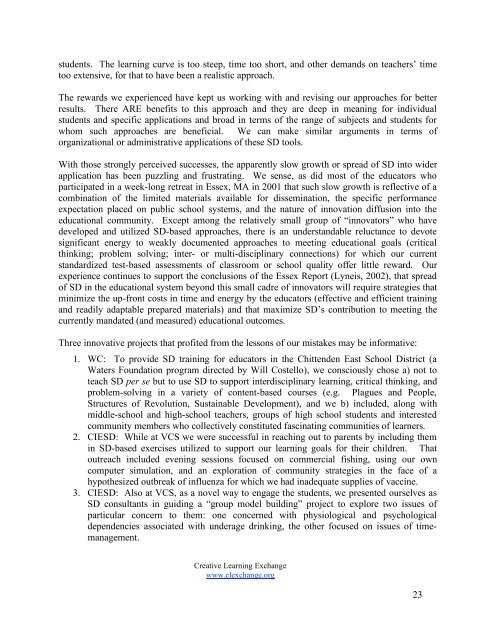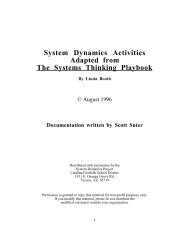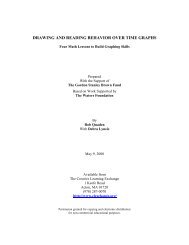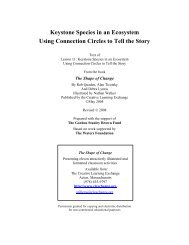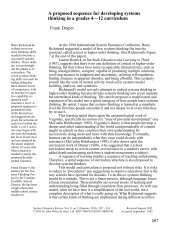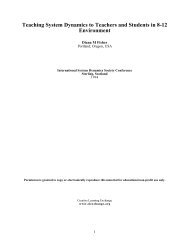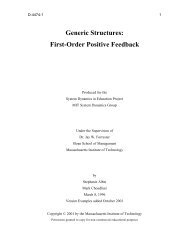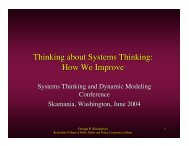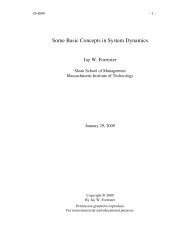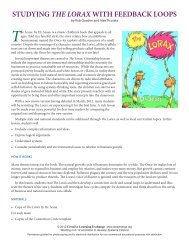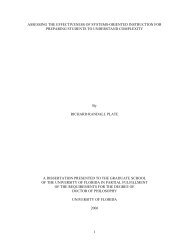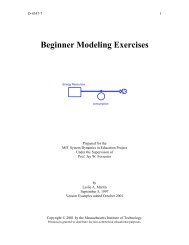System Dynamics in K-12 Education: Lessons Learned - Creative ...
System Dynamics in K-12 Education: Lessons Learned - Creative ...
System Dynamics in K-12 Education: Lessons Learned - Creative ...
You also want an ePaper? Increase the reach of your titles
YUMPU automatically turns print PDFs into web optimized ePapers that Google loves.
students. The learn<strong>in</strong>g curve is too steep, time too short, and other demands on teachers’ time<br />
too extensive, for that to have been a realistic approach.<br />
The rewards we experienced have kept us work<strong>in</strong>g with and revis<strong>in</strong>g our approaches for better<br />
results. There ARE benefits to this approach and they are deep <strong>in</strong> mean<strong>in</strong>g for <strong>in</strong>dividual<br />
students and specific applications and broad <strong>in</strong> terms of the range of subjects and students for<br />
whom such approaches are beneficial. We can make similar arguments <strong>in</strong> terms of<br />
organizational or adm<strong>in</strong>istrative applications of these SD tools.<br />
With those strongly perceived successes, the apparently slow growth or spread of SD <strong>in</strong>to wider<br />
application has been puzzl<strong>in</strong>g and frustrat<strong>in</strong>g. We sense, as did most of the educators who<br />
participated <strong>in</strong> a week-long retreat <strong>in</strong> Essex, MA <strong>in</strong> 2001 that such slow growth is reflective of a<br />
comb<strong>in</strong>ation of the limited materials available for dissem<strong>in</strong>ation, the specific performance<br />
expectation placed on public school systems, and the nature of <strong>in</strong>novation diffusion <strong>in</strong>to the<br />
educational community. Except among the relatively small group of “<strong>in</strong>novators” who have<br />
developed and utilized SD-based approaches, there is an understandable reluctance to devote<br />
significant energy to weakly documented approaches to meet<strong>in</strong>g educational goals (critical<br />
th<strong>in</strong>k<strong>in</strong>g; problem solv<strong>in</strong>g; <strong>in</strong>ter- or multi-discipl<strong>in</strong>ary connections) for which our current<br />
standardized test-based assessments of classroom or school quality offer little reward. Our<br />
experience cont<strong>in</strong>ues to support the conclusions of the Essex Report (Lyneis, 2002), that spread<br />
of SD <strong>in</strong> the educational system beyond this small cadre of <strong>in</strong>novators will require strategies that<br />
m<strong>in</strong>imize the up-front costs <strong>in</strong> time and energy by the educators (effective and efficient tra<strong>in</strong><strong>in</strong>g<br />
and readily adaptable prepared materials) and that maximize SD’s contribution to meet<strong>in</strong>g the<br />
currently mandated (and measured) educational outcomes.<br />
Three <strong>in</strong>novative projects that profited from the lessons of our mistakes may be <strong>in</strong>formative:<br />
1. WC: To provide SD tra<strong>in</strong><strong>in</strong>g for educators <strong>in</strong> the Chittenden East School District (a<br />
Waters Foundation program directed by Will Costello), we consciously chose a) not to<br />
teach SD per se but to use SD to support <strong>in</strong>terdiscipl<strong>in</strong>ary learn<strong>in</strong>g, critical th<strong>in</strong>k<strong>in</strong>g, and<br />
problem-solv<strong>in</strong>g <strong>in</strong> a variety of content-based courses (e.g. Plagues and People,<br />
Structures of Revolution, Susta<strong>in</strong>able Development), and we b) <strong>in</strong>cluded, along with<br />
middle-school and high-school teachers, groups of high school students and <strong>in</strong>terested<br />
community members who collectively constituted fasc<strong>in</strong>at<strong>in</strong>g communities of learners.<br />
2. CIESD: While at VCS we were successful <strong>in</strong> reach<strong>in</strong>g out to parents by <strong>in</strong>clud<strong>in</strong>g them<br />
<strong>in</strong> SD-based exercises utilized to support our learn<strong>in</strong>g goals for their children. That<br />
outreach <strong>in</strong>cluded even<strong>in</strong>g sessions focused on commercial fish<strong>in</strong>g, us<strong>in</strong>g our own<br />
computer simulation, and an exploration of community strategies <strong>in</strong> the face of a<br />
hypothesized outbreak of <strong>in</strong>fluenza for which we had <strong>in</strong>adequate supplies of vacc<strong>in</strong>e.<br />
3. CIESD: Also at VCS, as a novel way to engage the students, we presented ourselves as<br />
SD consultants <strong>in</strong> guid<strong>in</strong>g a “group model build<strong>in</strong>g” project to explore two issues of<br />
particular concern to them: one concerned with physiological and psychological<br />
dependencies associated with underage dr<strong>in</strong>k<strong>in</strong>g, the other focused on issues of timemanagement.<br />
<strong>Creative</strong> Learn<strong>in</strong>g Exchange<br />
www.clexchange.org<br />
23


